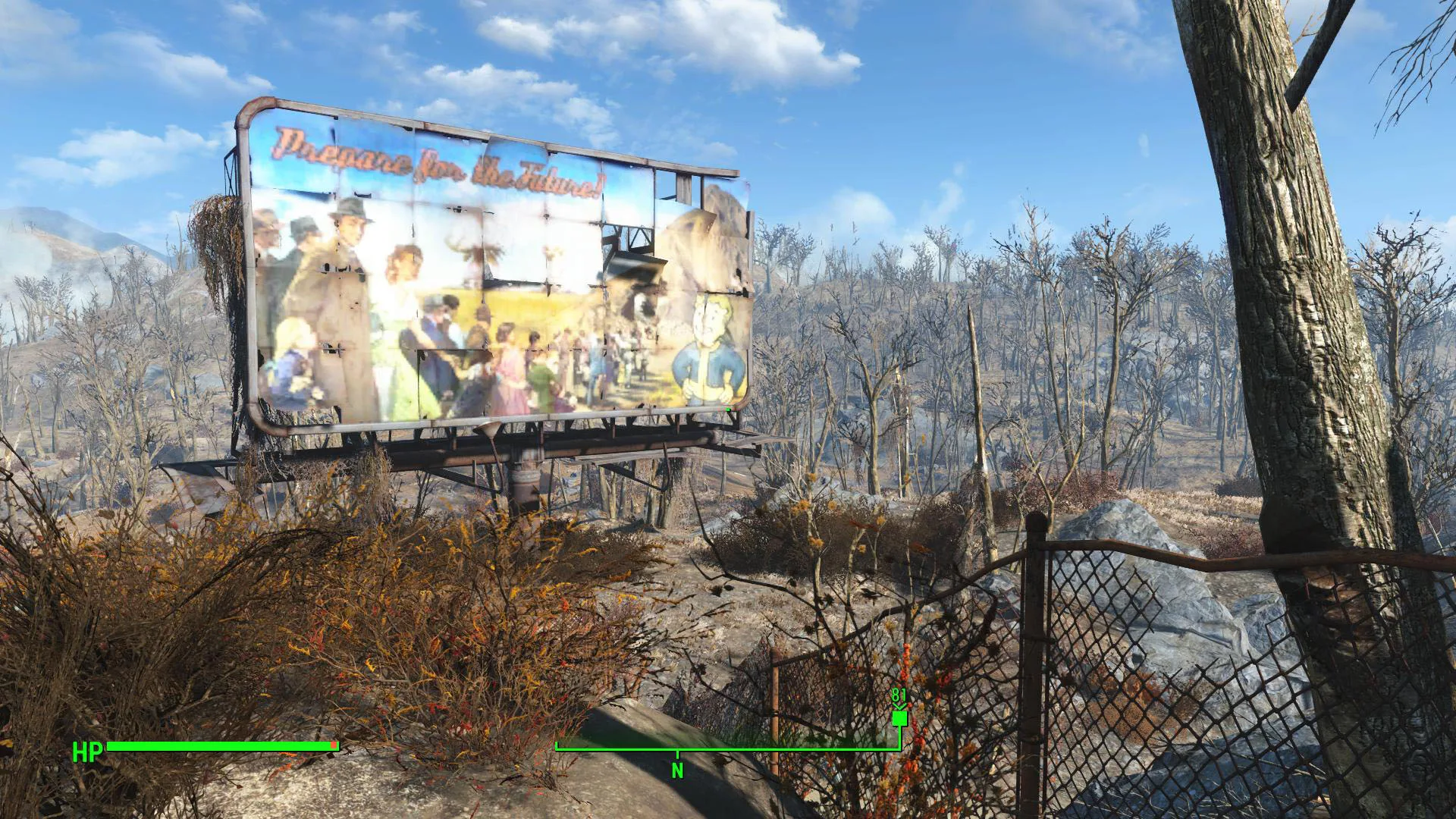As regularly featured by BabelTechReviews, this driver performance analysis charts the performance of 28 games using the latest GeForce WHQL 358.91 driver that was released primarily for Fallout 4, last week. We are comparing GeForce WHQL 358.91 versus the Geforce WHQL 358.50 driver that was released October 7, primarily for Star Wars: Battlefront beta. This time, we are going to focus on our latest benchmark, Fallout 4.
We have introduced something new at BTR. The Big Picture, once reserved for video card reviews is now included in every driver performance analysis. We are comparing the GTX 980 Ti versus the Fury X, the GTX 980 versus the R9 390X OC, the GTX 970 OC versus the R9 290X, and for added information, recent 290X CrossFire and GTX 980 SLI results. The Fury X is benchmarked with the Catalyst 15.9.1 betas, while the GTX 980 Ti/SLI and GTX 980 are on the very latest Nvidia GeForce 358.91 drivers.
 We want to document the performance changes of this current WHQL 358.91 driver on Windows 10. We are also currently benching for an upcoming evaluation of the new AMD Windows 10 15.11.1 beta driver for Fallout 4, and will update our Radeon results with the very latest Catalyst drivers for our next driver performance analysis and Big Picture.
We want to document the performance changes of this current WHQL 358.91 driver on Windows 10. We are also currently benching for an upcoming evaluation of the new AMD Windows 10 15.11.1 beta driver for Fallout 4, and will update our Radeon results with the very latest Catalyst drivers for our next driver performance analysis and Big Picture.
This driver performance analysis features Nvidia’s top Maxwell gaming GeForce card, the GTX 980 Ti, and we also benchmark GTX 980 Ti SLI and the GTX 980. We also added the GALAX GTX 970 EXOC results for our very latest DX11 benchmark, Fallout 4. We are going to give you the performance results of 28 games using the GTX 980, the GTX 980 Ti, and GTX 980 Ti SLI at 1920×1080, 2560×1440, and at 3840×2160 resolutions. This driver performance evaluation will chart a natural comparison of the performance changes since Nvidia’s last WHQL driver set.
Our testing platform is Windows 10 Home 64-bit, using an Intel Core i7-4790K at 4.00GHz which turbos to 4.4GHz for all cores, an ASUS Z97E motherboard, and 16GB of Kingston “Beast” HyperX DDR3 at 2133MHz. The settings and hardware are identical except for the drivers being tested.
At GTX 970 and above, we test at higher settings and resolutions generally than we test midrange and lower-end cards. All of our games are now tested at three resolutions: 3840×2160, 2560×1440 and 1920×1080 at 60Hz, and we use DX11 whenever possible with a very strong emphasis on the latest games. For our next GeForce performance analysis, we will add the GTX 970 results.
Let’s get right to the test configuration, the driver release notes, and then to the results.
Test Configuration & Driver Release Notes
Test Configuration – Hardware
- Intel Core i7-4790K (reference 4.0GHz, HyperThreading and Turbo boost is on to 4.4GHz; DX11 CPU graphics), supplied by Intel.
- ASUS Z97-E motherboard (Intel Z97 chipset, latest BIOS, PCIe 3.0 specification, CrossFire/SLI 8x+8x)
- Kingston 16 GB HyperX Beast DDR3 RAM (2×8 GB, dual-channel at 2133MHz, supplied by Kingston)
- GeForce GTX 980 Ti, 6GB reference clocks, supplied by Nvidia
- EVGA GTX 980 Ti, 6GB, at reference clocks, supplied by EVGA
- GeForce GTX 980, 4GB, reference clocks, supplied by Nvidia
- GALAX GTX 970 EXOC, GALAX factory clocks, supplied by GALAX
- 2TB Toshiba 7200 rpm HDD
- EVGA 1000G 1000W power supply unit
- Cooler Master 2.0 Seidon, supplied by Cooler Master
- Onboard Realtek Audio
- Genius SP-D150 speakers, supplied by Genius
- Thermaltake Overseer RX-I full tower case, supplied by Thermaltake
- ASUS 12X Blu-ray writer
- Monoprice Crystal Pro 4K
Test Configuration – Software
- Nvidia GeForce 358.91 WHQL drivers and GeForce 358.50 WHQL drivers for the GTX 980 and GTX 980 Ti, including for SLI. High Quality, prefer maximum performance, single display.
- VSync is off in the control panel.
- AA enabled as noted in games; all in-game settings are specified with 16xAF always applied
- All results show average frame rates except as noted.
- Highest quality sound (stereo) used in all games.
- Windows 10 64-bit Home edition, all DX11 titles were run under DX11 render paths. Our only DX12 title is run under the DX12 render path. Latest DirectX
- All games are patched to their latest versions at time of publication.
- EVGA’s PrecisionX, latest version.
The 28 Game benchmarks & 3 synthetic tests
- Synthetic
- Firestrike – Basic & Extreme
- Heaven 4.0
- Kite Demo, Unreal Engine 4
-
DX11
- STALKER, Call of Pripyat
- the Secret World
- Sleeping Dogs
- Hitman: Absolution
- Tomb Raider: 2013
- Crysis 3
- BioShock: Infinite
- Metro: Last Light Redux (2014)
- Battlefield 4
- Thief
- Sniper Elite 3
- GRID: Autosport
- Middle Earth: Shadows of Mordor
- Alien Isolation
- Assassin’s Creed Unity
- Far Cry 4
- Dragon’s Age: Inquisition
- The Crew
- Total War: Attila
- Wolfenstein: The Old Blood
- Grand Theft Auto V
- ProjectCARS
- the Witcher 3
- Batman: Arkham Origins
- Mad Max
- Metal Gear Solid V: The Phantom Pain
- Fallout 4
- DX12 Games
- Ashes of the Singularity – Alpha Demo benchmark
Let’s first look at Fallout 4 performance using the GTX 980 Ti, 980 Ti SLI, GTX 980, and the GALAX GTX 970 EXOC.
Fallout 4
Fallout 4 is one of the most anticipated games of 2015. It is a huge open world game very much in the style of the earlier Fallout games, and it is very similar to Oblivion and Skyrim with their emphasis on exploring, fighting, extremely detailed crafting, factions, choices, leveling up, and character development. It is a very addictive game that pulls the player immediately into the Fallout world, even if they have no experience with with the earlier Fallout games.
As the sole survivor of Vault 111, you enter a changed world 200 years in the future, and it is one that is destroyed by nuclear war. You are the chosen one who can rebuild and determine the fate of the Wasteland as you fight for your own survival.
Fallout 4 has generally very good graphics that features Nvidia’s GameWorks, which uses Volumetric Lighting. It’s an advanced lighting system that models how light behaves as it streams through the air and atmosphere. Volumetric Lighting provides a greater sense of immersion through rich and ever changing environmental effects, and they are rather demanding.
The benchmark that we chose for Fallout 4 is quite challenging at higher resolutions with all “Ultra” and fully maxed-out settings. Each setting is fully maxed-out including God Rays, which is normally “High” when the default Ultra settings are chosen. Here are the settings that we used. 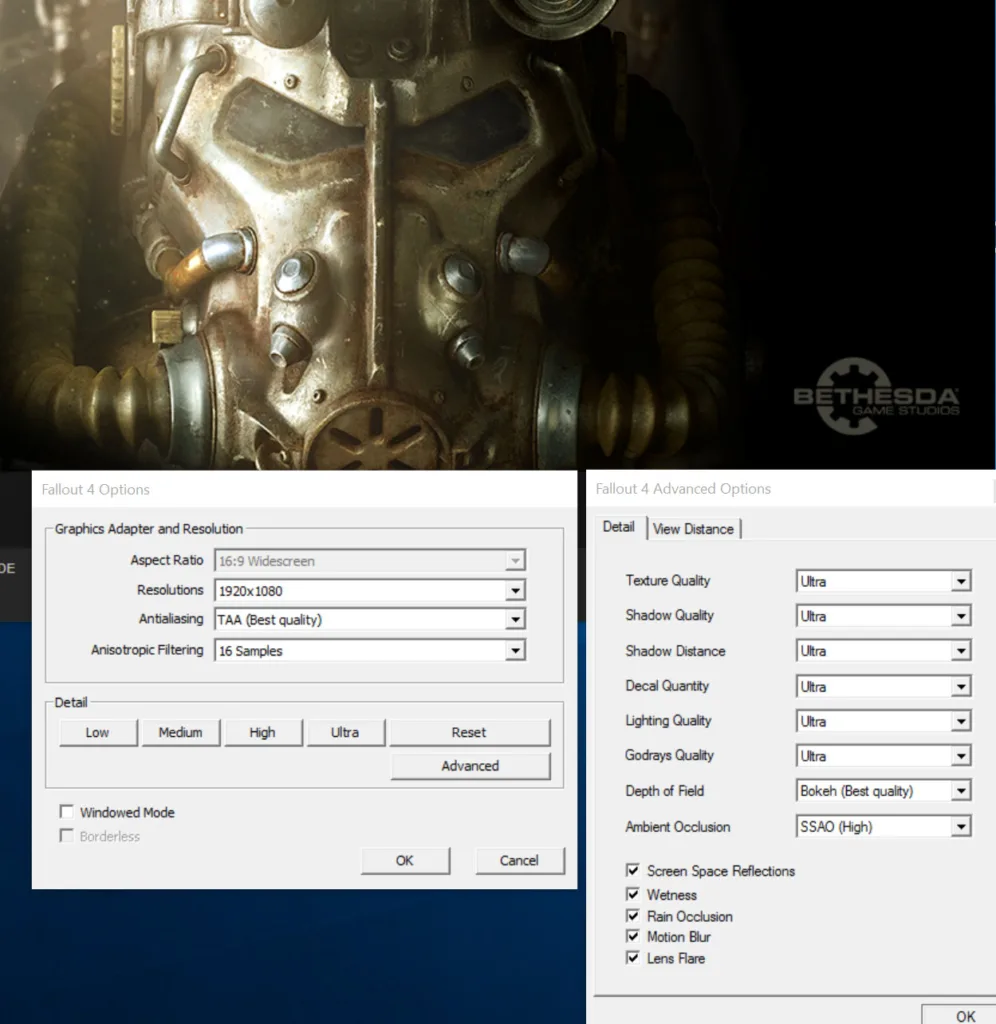
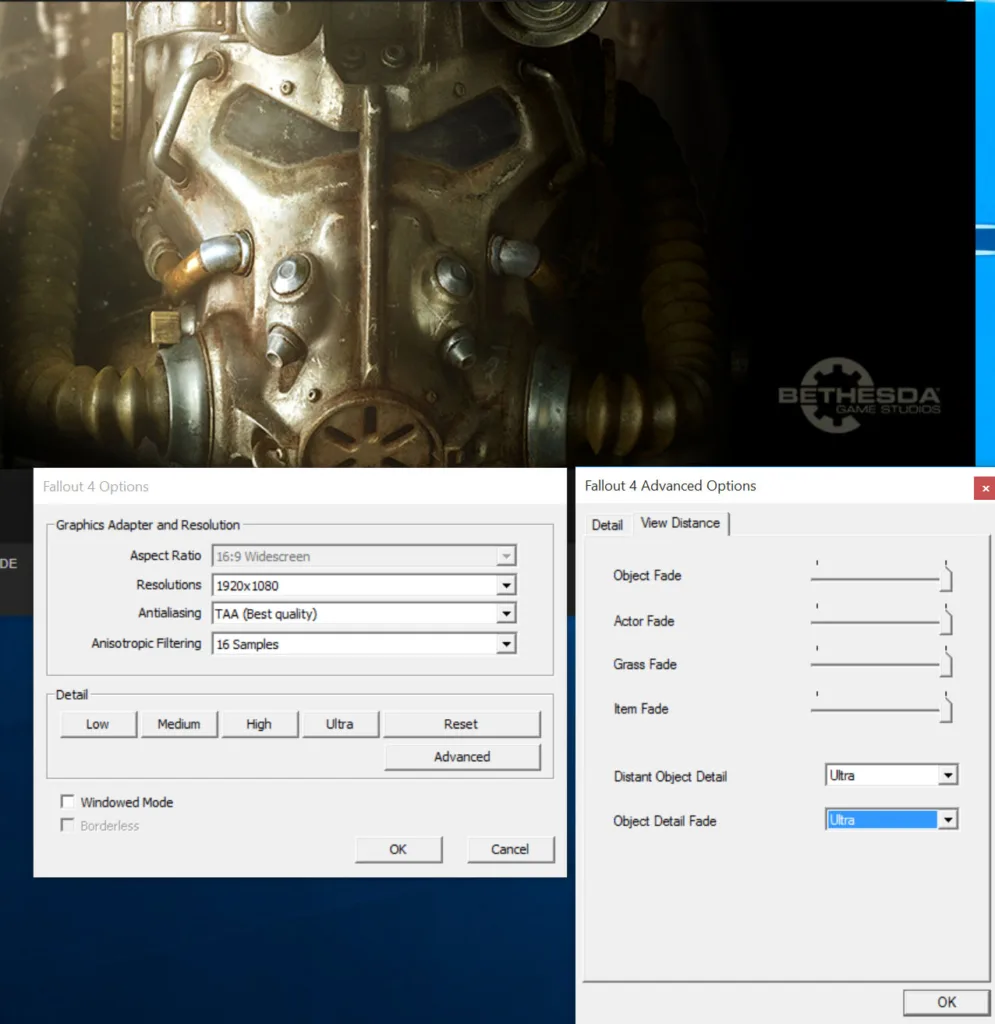 Here are the DX11 performance results benching Fallout 4 for the GALAX GTX 970 EXOC, the GTX 980, the GTX 980 Ti, and GTX 980 Ti SLI. Note that our GTX 980 Ti SLI is not yet working as there is no official profile for it yet.
Here are the DX11 performance results benching Fallout 4 for the GALAX GTX 970 EXOC, the GTX 980, the GTX 980 Ti, and GTX 980 Ti SLI. Note that our GTX 980 Ti SLI is not yet working as there is no official profile for it yet.  BTR’s Fallout 4 is a very consistent DX11 benchmark which uses one of the more demanding outdoor sections of Fallout 4. Sometimes the game itself will present further slowdowns, often in indoor areas, and during extreme combat. We expect that there will be further optimizations and driver improvements, and we will continue to chart Fallout 4’s performance as it has become BTR’s latest benchmark.
BTR’s Fallout 4 is a very consistent DX11 benchmark which uses one of the more demanding outdoor sections of Fallout 4. Sometimes the game itself will present further slowdowns, often in indoor areas, and during extreme combat. We expect that there will be further optimizations and driver improvements, and we will continue to chart Fallout 4’s performance as it has become BTR’s latest benchmark.
Lets look at Nvidia’s release highlights regarding the GeForce 358.91 WHQL driver before we head to performance testing.
Release Notes Highlights for GeForce 358.91
This is a short list highlighting the fact that Nvidia’s WHQL driver release schedule is continuing to be tied to the release of AAA games.
Prior to a new title launching, our driver team is working up until the last minute to ensure every performance tweak and bug fix possible makes it into the Game Ready driver. As a result, you can be sure you’ll have the best day-1 gaming experience for your favorite new titles.
Game Ready
Learn more about how to get the optimal experience for Fallout 4, Star Wars: Battlefront, and StarCraft II: Legacy of the Void.
For the comprehensive release notes, you will need to download the .pdf
Let’s head to the chart and compare the driver progress with the GTX 980, the GTX 980 Ti, and with the GTX 980 Ti SLI since we tested the last time.
Benchmarks & Performance Analysis
Here are our results of 28 games and 3 synthetics compared between GeForce 358.91 WHQL drivers, and GeForce 358.50 WHQL drivers using the GTX 980, theGTX 980 Ti, and GTX 980 Ti SLI. Each set of WHQL drivers are compared against the other in the adjoining results column and the higher performance number is in bold. If there is a tie, both results are given in bold type. 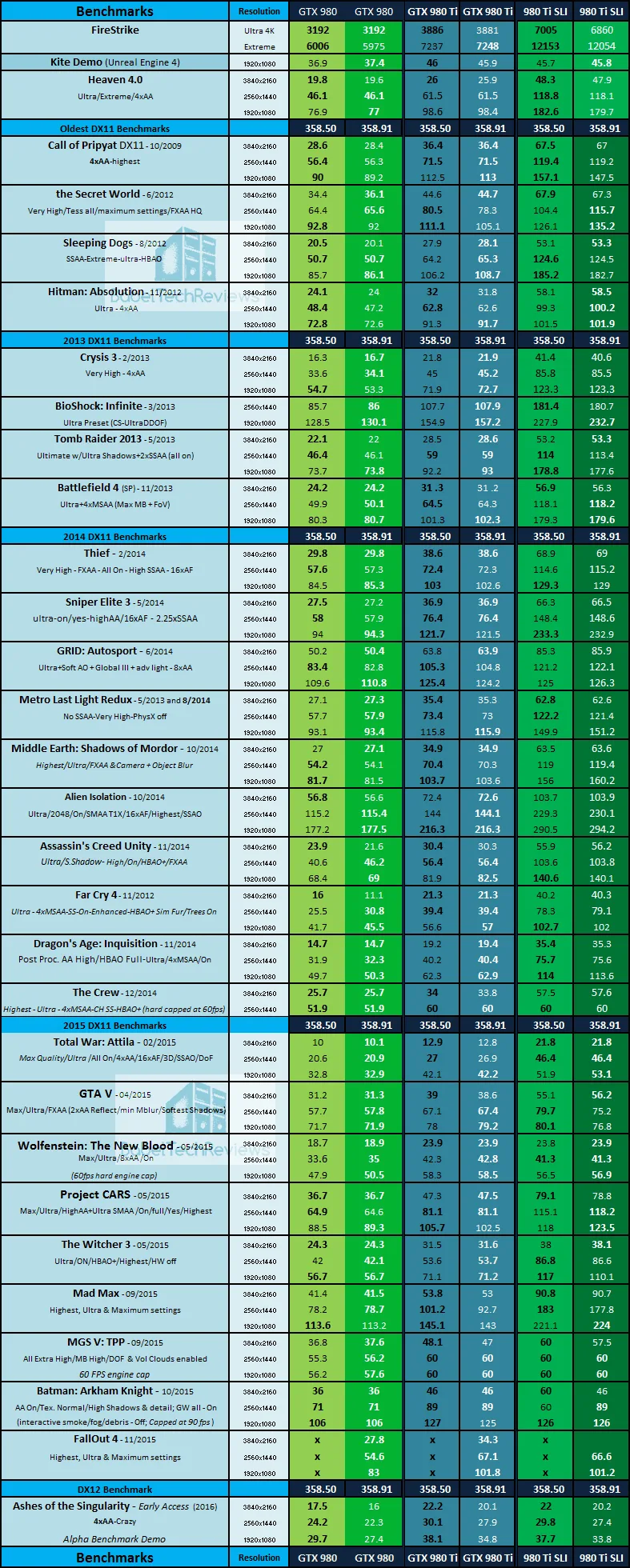
As usual, we note mostly incremental improvements with the latest WHQL drivers, and they are generally positive. The only big negative was with the DX12 Alpha Benchmark of Ashes of the Singularity which got two mega patches just before GeForce 358.91 drivers were released
The Big Picture
The Big Picture, once reserved solely for video card reviews, has been recently expanded to feature all of our competing top video cards on recent drivers. We are benching the GTX 980 Ti versus the Fury X, the GTX 980 versus the R9 390X OC, the GTX 970 OC versus the R9 290X; and for added information, 290X CrossFire and GTX 980 SLI results. The Fury X results are from older Catalyst 15.9.1 betas, and the GTX 980 Ti/SLI and GTX 980 are on the very latest Nvidia 358.91 drivers. The 290X/CF and 390X are on Catalyst 15.8 and the GTX 970 EXOC (except for Fallout 4) is on GeForce 355.82 as shown on the top and last lines of the chart.
This time, “X” means the benchmark was not run, and “NA” means the benchmark could not be run or completed. And an Asterisk (*) means that there are some real issues with the visuals.
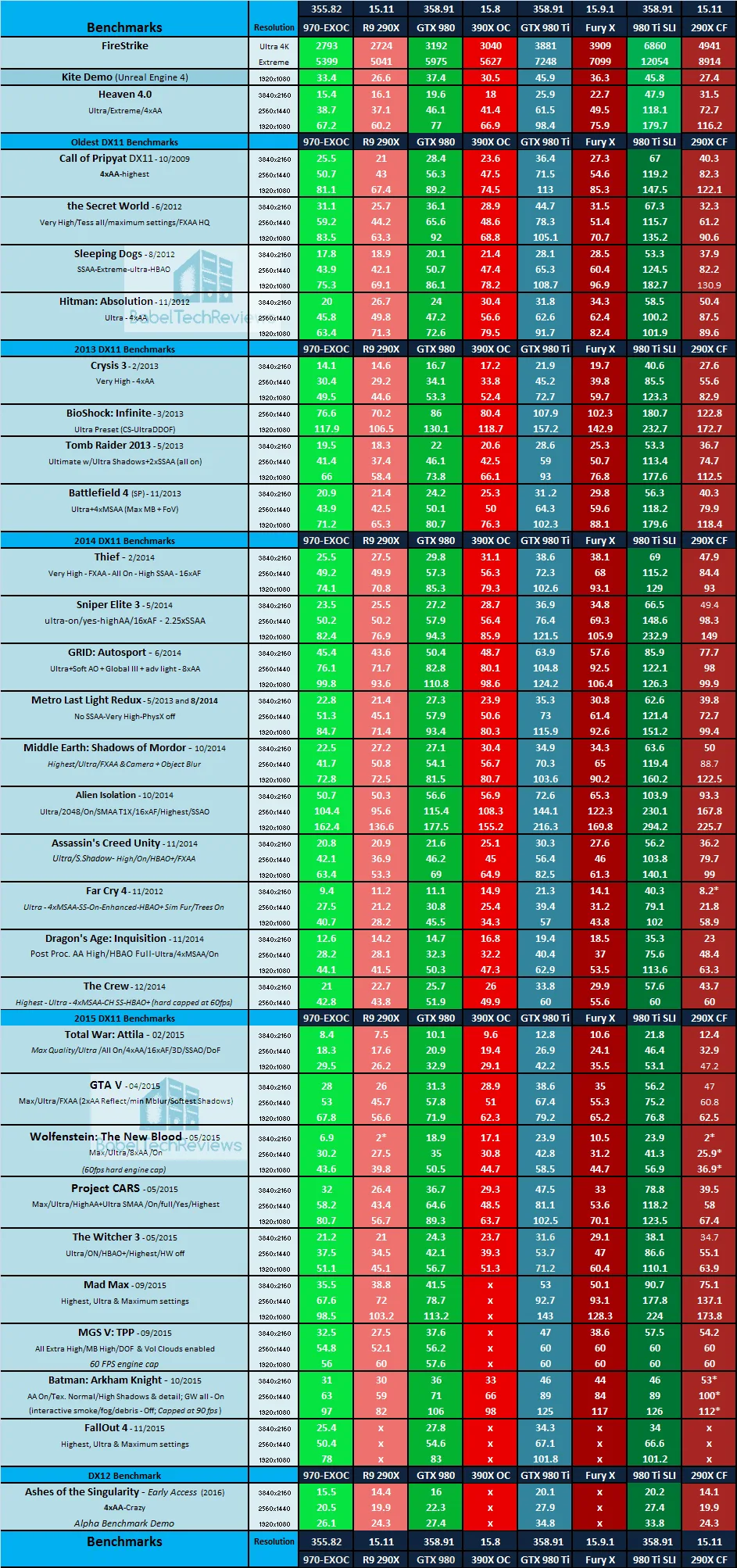 We will completely update our Big Picture when we benchmark the latest Catalyst 15.11.1 Beta Drivers which were just released yesterday. Let’s head to our conclusion.
We will completely update our Big Picture when we benchmark the latest Catalyst 15.11.1 Beta Drivers which were just released yesterday. Let’s head to our conclusion.
Conclusion:
We would recommend upgrading to the latest GeForce 358.91 drivers because there are generally incremental advantages, and no large performance-impacting negatives that we have encountered. It is Nvidia’s latest WHQL driver for Windows 10, and we will be using it this week to compare with the performance of AMD’s latest Catalyst 15.11.1 Beta driver.
GeForce 358.91 is also the driver to use for the latest really fun games that we are playing, including Mad Max, Metal Gear Solid V: The Phantom Pain, and especially for Fallout 4. It appears that Nvidia intends to release a WHQL driver with each new major PC game release, and we are looking forward to evaluating the next GeForce driver which may be coming very soon for Star Wars: Battlefront.
Stay tuned, next up we are benching for an upcoming driver performance evaluation of AMD’s newest Catalyst 15.11.1 Windows 10 beta driver, again featuring Fallout 4.
Happy gaming!
